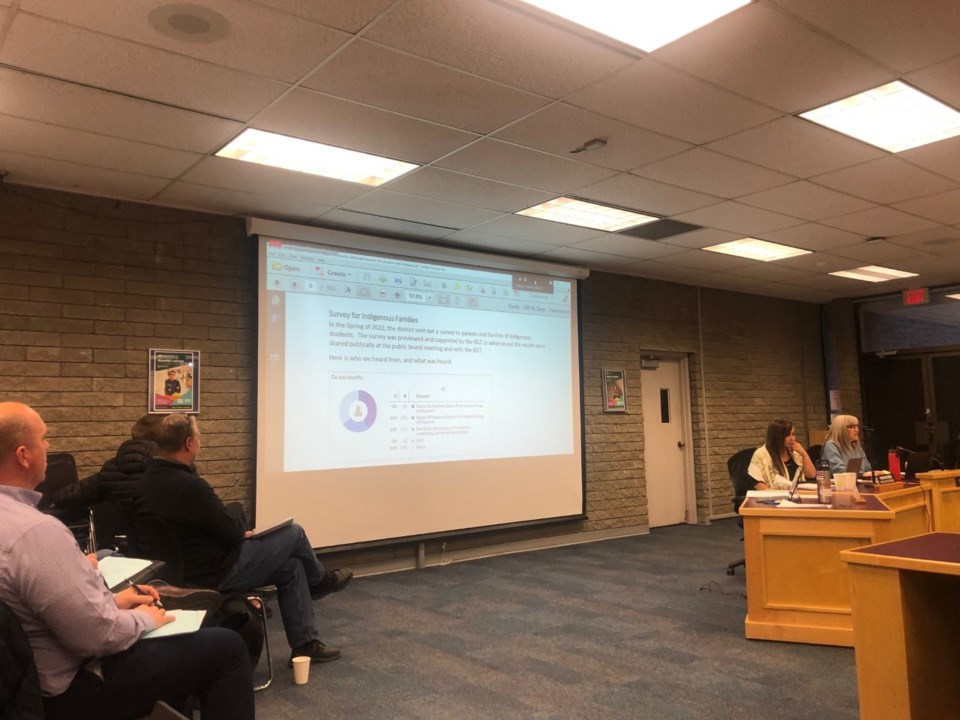A new report is detailing School District No. 57 (SD57)’s work toward improving Indigenous education outcomes in the district.
SD57 is required to submit this information to the Minister of Education and childcare, Jennifer Whiteside, every two months as part of its work with a special advisory committee appointed to address issues of systemic racism within the district.
The report submitted on Oct. 15 details a summary of student outcomes from the 2021/22 school year.
The district was asked to report on the number of Indigenous students assessed as “not ready” for kindergarten and actions take to increase readiness; the number of Indigenous students on partial day attendance; the number of Indigenous students suspended; the number of Indigenous students enrolled in alternate programs; and the outcomes of the work of Indigenous Grad Coaches.
Superintended Cindy Heitman presented this information to the public at SD57’s Oct. 25 board of education meeting.
Heitman explained that in the 2021/22 school year she reported the data in the District’s How are We Doing? (HAWD) report which is meant to make public the outcomes of Indigenous learners, keep the topic on Indigenous Education at the forefront, and practice using data to review systems and structure.
In the HAWD report, there is clear evidence that the number of Adult Dogwoods in School District 57 continues to decrease for both Indigenous and non-Indigenous learners.
Indigenous Grad Coaches were introduced in the 2021/22 school year. These positions were increased in secondary schools for the 2022/23 school year and additional support to assist and track Indigenous students was also introduced.
“We focused on grade 10, 11, and 12 students identifying who is at risk, who is on the fence and who is on track for a regular dogwood,” said Heitman.
“After one year of working with Indigenous grad coaches, we saw some gains at the grade 10 level. We saw 22 more students who are no longer at risk, and 27 more students who are on track for graduating with a regular dogwood.”
The numbers also improved for grade 11 and with 27 students no longer at risk and 31 students on track for graduating. In grade 12, 60 students were no longer at risk and 38 students were on track for graduating and 22 students chose to stay in school an extra year to improve their grades.
“What we learned from this was the value we had with our Indigenous grad coaches and as a result, we have increased the time that our grad coaches are working with students in schools,” said Heitman.
The report to the Special Advisors also included a survey of the parents and families of Indigenous students. The survey was previewed and supported by the Indigenous Education Leadership Table.
It asked questions like do you feel welcomed when you go into our schools and buildings? Do you feel a sense of belonging within SD57?
The answers show that 38 per cent of respondents feel welcome all of the time, 33 per cent said most of the time, 18 per cent said some of the time, 9 per cent have felt welcome a few times, and 2 per cent never feel welcome.
“This one made me feel a little bit happier in that I wasn’t expecting it to be this high and I will say that truthfully,” said Heitman.
“But when I look at this over a quatre of our families still don’t feel welcome and still don’t feel like they belong in our schools and as you know this is a focus of our district and something that we have been working on through our strategic plan.”
The report also showed an over-representation of Indigenous students being suspended in the district.
Data from the 2021/22 school year indicated of the 1338 in-school and out-of-school suspensions 48 per cent were Indigenous students and of that number many incidents were repeat offenses by the same students.
“When we have 30 per cent of an indigenous population and our suspension rate is 50 per cent there is definitely over-representation of indigenous students being suspended which posed even more questions for us,” said Heitman.
“We have big questions of what is going on in grade 9 and 10, and that is work for us to do as we explore what is happening in our secondary schools.”
She said they plan on analyzing suspension data by incident, by grade, and the number of students that are suspended more than once.
“Suspension is not an intervention and if a student is continuously being suspended it is an indicator that a student needs an intervention and support.”
Heitman also noted this report is the beginning of a lot more work to come and the data and analysis will be expanded upon in the December report.
The full 100-page report also is available to view on SD57’s website.







